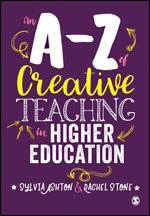 Sage Publications released An A-Z of Creative Teaching in Higher Education earlier this year. The co-authors are Sylvia Ashton, an independent educational consultant, and Rachel Stone of Sheffield Hallam University, UK. As one might expect, the chapters of the book are organized by the letters of the alphabet: A is for Action, E is for Emotion, G is for Groups, etc. Through this organization, they are able to pull together research on many different topics related to college teaching with an emphasis on innovation and creativity. The authors provide case studies, practical examples, and practical suggestions along with recommendations for further reading. The 248-page book is available for $32.85 on Amazon or $26.00 in Kindle format.
Sage Publications released An A-Z of Creative Teaching in Higher Education earlier this year. The co-authors are Sylvia Ashton, an independent educational consultant, and Rachel Stone of Sheffield Hallam University, UK. As one might expect, the chapters of the book are organized by the letters of the alphabet: A is for Action, E is for Emotion, G is for Groups, etc. Through this organization, they are able to pull together research on many different topics related to college teaching with an emphasis on innovation and creativity. The authors provide case studies, practical examples, and practical suggestions along with recommendations for further reading. The 248-page book is available for $32.85 on Amazon or $26.00 in Kindle format.
Posted by: Gregory Linton | 12/13/2018
Higher Ed Resource of the Week: An A-Z of Creative Teaching in Higher Education
Posted in Higher education, Instructional design, Pedagogy, Teaching strategies | Tags: college teaching, creativity, Instructional design
Categories
- Higher education
- Pedagogy
- Academic dishonesty
- Accessibility
- Biblical higher education
- Christian education
- Clickers
- Cognitive load theory
- Cognitive science
- Coherence
- Community of practice
- Core competencies
- creativity
- Critical thinking
- Curriculum design
- Deep learning
- Faculty development
- Faculty learning community
- Faculty-student relationship
- First-generation Students
- First-year experience
- General education
- Grade inflation
- Grading
- Graduation rate
- Inclusive Classrooms
- Instructional design
- Intensive courses
- Learning organization
- Lectures
- Mathematics
- Multiculturalism
- neuroscience of learning
- Note taking
- OER
- Online teaching
- Plagiarism
- Problem Solving
- Quantitative literacy
- Relevance
- Scholarship of teaching & learning
- Soft skills
- Student cheating
- Student learning outcomes
- Student response system
- Student retention
- Teaching strategies
- Techology
- Universal design for learning
- Video games
- Writing instruction
- Policy
- Academic administration
- Academic planning
- Assessment of learning
- Benefits of college
- College rankings
- College readiness
- Course evaluations
- Course scheduling
- Curriculum requirements
- Demographics
- Enrollment management
- Finances
- Gender gap
- Higher ed reform
- History of higher ed
- Honor codes
- Innovation
- Institutional advancement
- Liberal arts
- Male students
- Nontraditional students
- Online education
- Retention
- Skills gap
- Student evaluations of teaching
- Student mental health
- Student mobility
- trends
- Workforce readiness
Leave a comment